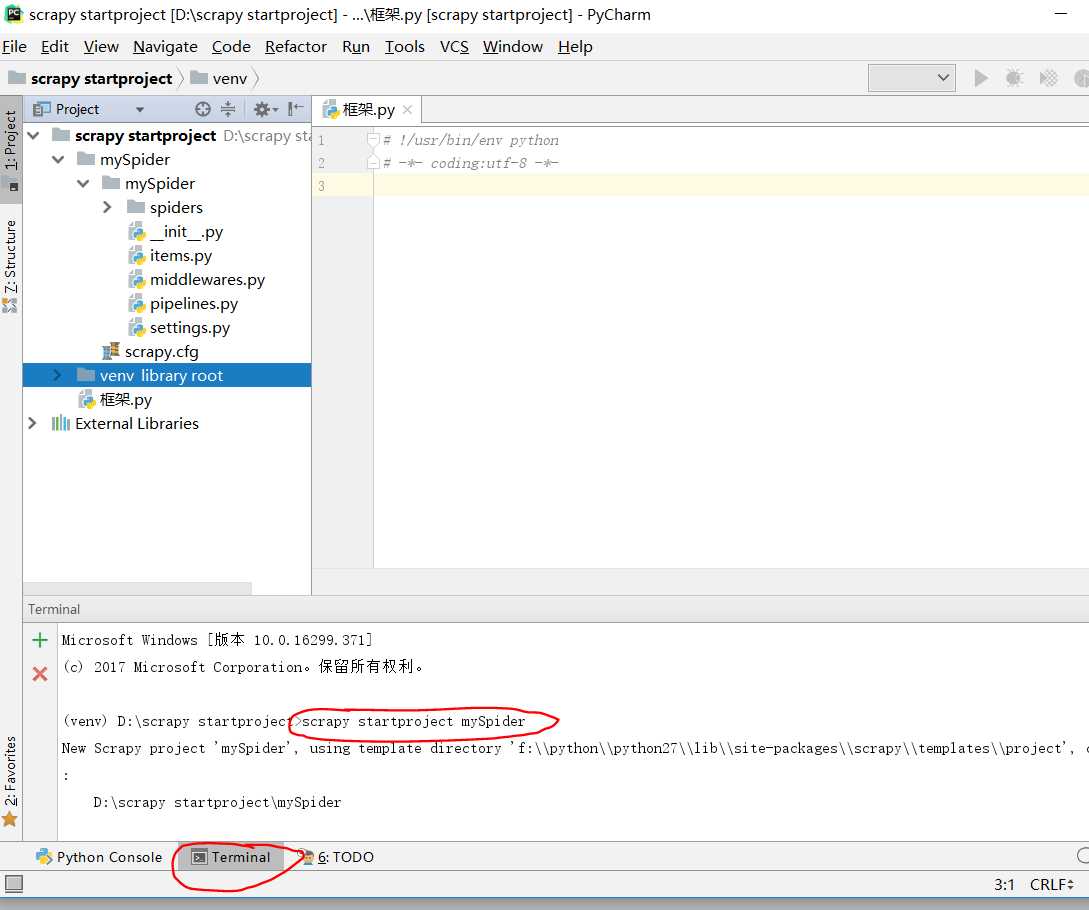标签:IV 2.x 取数据 案例 包含 number 结果 调用 ams
scrapy startproject mySpider

下面来简单介绍一下各个主要文件的作用:
scrapy.cfg :项目的配置文件
mySpider/ :项目的Python模块,将会从这里引用代码
mySpider/items.py :项目的目标文件
mySpider/pipelines.py :项目的管道文件
mySpider/settings.py :项目的设置文件
mySpider/spiders/ :存储爬虫代码目录
我们打算抓取:http://www.itcast.cn/channel/teacher.shtml 网站里的所有讲师的姓名、职称和个人信息。
打开mySpider目录下的items.py
Item 定义结构化数据字段,用来保存爬取到的数据,有点像Python中的dict,但是提供了一些额外的保护减少错误。
可以通过创建一个 scrapy.Item 类, 并且定义类型为 scrapy.Field的类属性来定义一个Item(可以理解成类似于ORM的映射关系)。
接下来,创建一个ItcastItem 类,和构建item模型(model)。
import scrapy
class ItcastItem(scrapy.Item):
name = scrapy.Field()
level = scrapy.Field()
info = scrapy.Field()
爬虫功能要分两步:
mySpider/spider目录下创建一个名为itcast的爬虫,并指定爬取域的范围:scrapy genspider itcast "itcast.cn"
import scrapy
class ItcastSpider(scrapy.Spider):
name = "itcast"
allowed_domains = ["itcast.cn"]
start_urls = (
‘http://www.itcast.cn/‘,
)
def parse(self, response):
pass
要建立一个Spider, 你必须用scrapy.Spider类创建一个子类,并确定了三个强制的属性 和 一个方法。
name = "" :这个爬虫的识别名称,必须是唯一的,在不同的爬虫必须定义不同的名字。
allow_domains = [] 是搜索的域名范围,也就是爬虫的约束区域,规定爬虫只爬取这个域名下的网页,不存在的URL会被忽略。
start_urls = () :爬取的URL元祖/列表。爬虫从这里开始抓取数据,所以,第一次下载的数据将会从这些urls开始。其他子URL将会从这些起始URL中继承性生成。
parse(self, response) :解析的方法,每个初始URL完成下载后将被调用,调用的时候传入从每一个URL传回的Response对象来作为唯一参数,主要作用如下:
start_urls = ("http://www.itcast.cn/channel/teacher.shtml",)
def parse(self, response):
filename = "teacher.html"
open(filename, ‘w‘).write(response.body)
然后运行一下看看,在mySpider目录下执行:
scrapy crawl itcast
是的,就是 itcast,看上面代码,它是 ItcastSpider 类的 name 属性,也就是使用 scrapy genspider命令的唯一爬虫名。
运行之后,如果打印的日志出现 [scrapy] INFO: Spider closed (finished),代表执行完成。 之后当前文件夹中就出现了一个 teacher.html 文件,里面就是我们刚刚要爬取的网页的全部源代码信息。
# 注意,Python2.x默认编码环境是ASCII,当和取回的数据编码格式不一致时,可能会造成乱码;
# 我们可以指定保存内容的编码格式,一般情况下,我们可以在代码最上方添加:
import sys
reload(sys)
sys.setdefaultencoding("utf-8")
# 这三行代码是Python2.x里解决中文编码的万能钥匙,经过这么多年的吐槽后Python3学乖了,默认编码是Unicode了...(祝大家早日拥抱Python3)
<div class="li_txt">
<h3> xxx </h3>
<h4> xxxxx </h4>
<p> xxxxxxxx </p>
from mySpider.items import ItcastItem
ItcastItem 对象中,可以保存每个老师的属性:from mySpider.items import ItcastItem
def parse(self, response):
#open("teacher.html","wb").write(response.body).close()
# 存放老师信息的集合
items = []
for each in response.xpath("//div[@class=‘li_txt‘]"):
# 将我们得到的数据封装到一个 `ItcastItem` 对象
item = ItcastItem()
#extract()方法返回的都是unicode字符串
name = each.xpath("h3/text()").extract()
title = each.xpath("h4/text()").extract()
info = each.xpath("p/text()").extract()
#xpath返回的是包含一个元素的列表
item[‘name‘] = name[0]
item[‘title‘] = title[0]
item[‘info‘] = info[0]
items.append(item)
# 直接返回最后数据
return items
# json格式,默认为Unicode编码
scrapy crawl itcast -o teachers.json
# json lines格式,默认为Unicode编码
scrapy crawl itcast -o teachers.jsonl
# csv 逗号表达式,可用Excel打开
scrapy crawl itcast -o teachers.csv
# xml格式
scrapy crawl itcast -o teachers.xml
from mySpider.items import ItcastItem
def parse(self, response):
#open("teacher.html","wb").write(response.body).close()
# 存放老师信息的集合
#items = []
for each in response.xpath("//div[@class=‘li_txt‘]"):
# 将我们得到的数据封装到一个 `ItcastItem` 对象
item = ItcastItem()
#extract()方法返回的都是unicode字符串
name = each.xpath("h3/text()").extract()
title = each.xpath("h4/text()").extract()
info = each.xpath("p/text()").extract()
#xpath返回的是包含一个元素的列表
item[‘name‘] = name[0]
item[‘title‘] = title[0]
item[‘info‘] = info[0]
#items.append(item)
#将获取的数据交给pipelines
yield item
# 返回数据,不经过pipeline
#return items标签:IV 2.x 取数据 案例 包含 number 结果 调用 ams
原文地址:https://www.cnblogs.com/lmx123/p/9248344.html